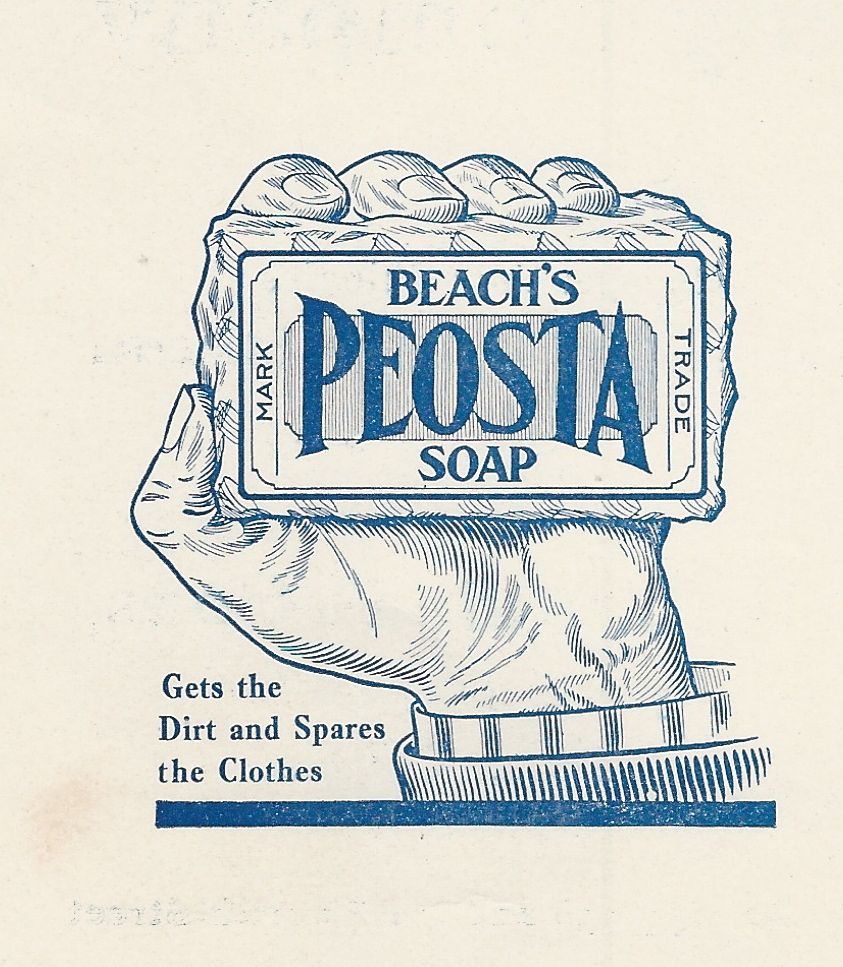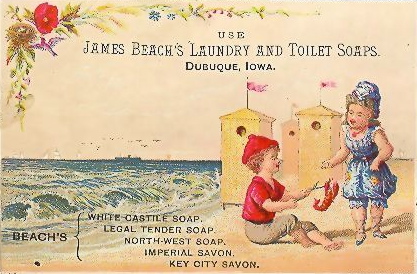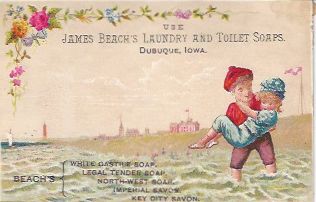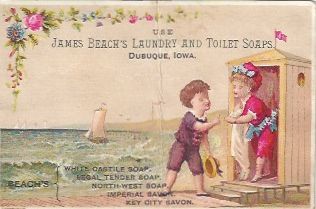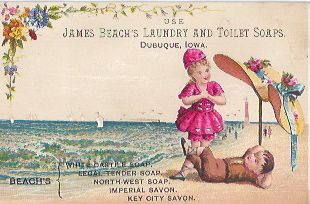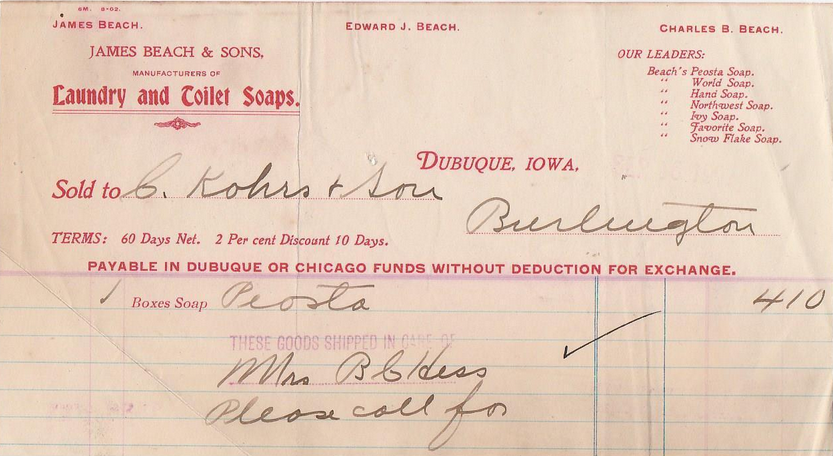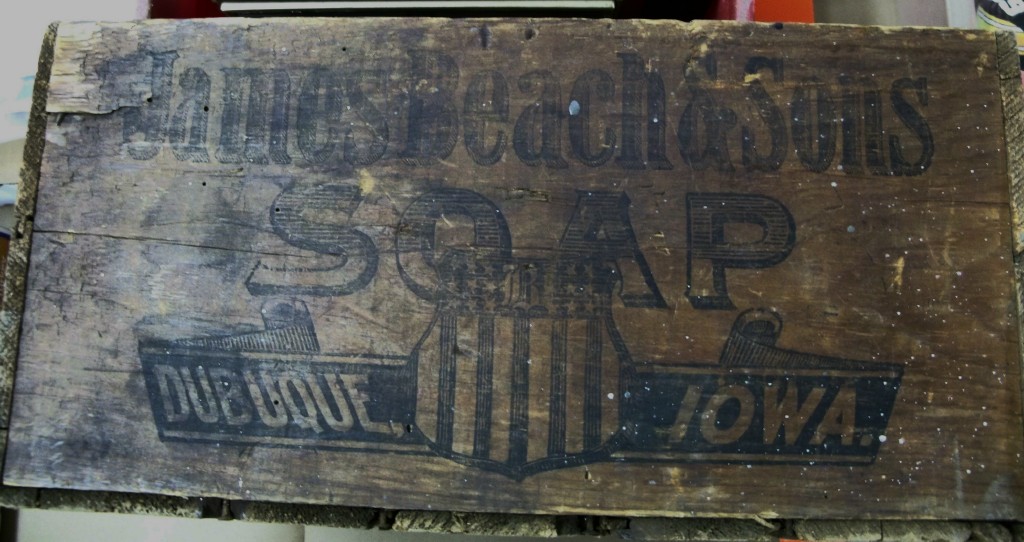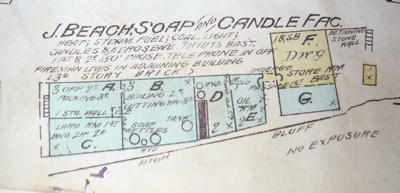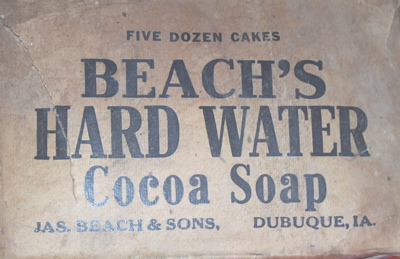Encyclopedia Dubuque
"Encyclopedia Dubuque is the online authority for all things Dubuque, written by the people who know the city best.”
Marshall Cohen—researcher and producer, CNN
Affiliated with the Local History Network of the State Historical Society of Iowa, and the Iowa Museum Association.
JAMES BEACH AND SONS: Difference between revisions
(Created page with "left|thumb|300px|Photo courtesy: Jim Massey left|thumb|200px|Front of trade card.Photo courtesy: Bob RedingJAMES BEACH AND SON...") |
No edit summary |
||
| (14 intermediate revisions by the same user not shown) | |||
| Line 1: | Line 1: | ||
[[Image:peosta soap.png|left|thumb|300px|Packing box]] | |||
[[Image:peostasoap.jpg|left|thumb|300px|Photo courtesy: Jim Massey]] | [[Image:peostasoap.jpg|left|thumb|300px|Photo courtesy: Jim Massey]] | ||
[[Image:beachcard.jpg|left|thumb|200px|Front of trade card.Photo courtesy: Bob Reding]]JAMES BEACH AND SONS. | [[Image:beachcard.jpg|left|thumb|200px|Front of trade card.Photo courtesy: Bob Reding]]JAMES BEACH AND SONS. In 1858 [[BEACH, James|James BEACH]] purchased the interest of [[FARLEY, Jesse P.|Jesse P. FARLEY]] in the [[DUBUQUE LARD-OIL, SOAP, AND CANDLE FACTORY]]. Candle production was dropped and the company was renamed [[PLEINS & BEACH]]. | ||
[[PLEINS, F. M.|F. M. PLEINS]] left Dubuque in 1859 after selling his interest in the company to his partner. (1) Business increased so rapidly that improvements were completed on a two-story stone factory proper, 136x55 feet, with an addition used for warehouse purposes, 50x40 feet; the whole costing about $16,000. The buildings were located in the square bounded by Locust and Dodge [[STREETS]], having a frontage of 417 feet on the former street, with a depth of 300 feet on Dodge street. Indicating the volume of business, the shipments of soap, especially the "World" brand, exceeded 75,000 pounds between May 1 and 23rd, 1886. (2) | |||
James Beach's son, [[BEACH, Edward James|Edward James BEACH]], joined the business beginning in December, 1890. To supply the increasing demand for washing and toilet soap, the company in 1891 constructed a three-story brick building on the same location which doubled their capacity. (3) Years later this building was used by [[A.Y.MCDONALD MANUFACTURING COMPANY]]. Employment increased to forty. Beach's second son. Jim, came into the business and the company name became James Beach and Sons. It retained this name even after the eldest son, George, joined the firm. | |||
In 1906 machinery was installed for the production of soap powder. This made the company the first soap powder mill in Iowa. Advertising samples were given to local housewives to encourage interest. (4) The company was then producing eight million pounds of soap annually with oils from Ceylon and corn oil used to give fragrances to some of the finer toilet soaps. The most popular laundry brand was "Peosta" with other types named "North West," "World," and "White Castile." While sold nationwide, most of the business came from the Midwest. (5) | |||
In 1911 the force required to work the factory averaged from seven to ten employees, at a total weekly cost of from $100 to $150. The articles manufactured included lard-oil, tallow candles and soaps ranging in quality from the common domestic to the choicer grades. The firm annually produced upward of ten thousand boxes of soap of the following brands: White Castile, Legal Tender, Peerless, Royal, Blue, Key City, Imperial, German and Family; from three thousand to thirty-five hundred summer-pressed and molded candles, and from three to five hundred barrels of extra winter-strained lard-oil, employing eight presses. | |||
In January, 1915 James Beach and Sons converted to two smokeless furnaces to avoid the violation of the smoke abatement ordinance passed by the city council in December, 1914. Similar furnaces had been in operation for several days at the [[BANK AND INSURANCE BUILDING]] which had the dubious reputation of having the smokiest chimneys in the city. (6) | |||
Upon the death of James Beach the company was renamed Beach Brothers. The company closed in 1930. (6) | |||
[[Image:beachcard2.jpg|right|thumb|200px|Back of trade card]] | [[Image:beachcard2.jpg|right|thumb|200px|Back of trade card]] | ||
[[Image:beach1.jpg|left|thumb|200px|Photo courtesy: Bob Reding]] | [[Image:beach1.jpg|left|thumb|200px|Photo courtesy: Bob Reding]] | ||
[[Image:beach2.jpg|left|thumb|200px|Photo courtesy: Bob Reding]] | [[Image:beach2.jpg|left|thumb|200px|Photo courtesy: Bob Reding]] | ||
[[Image:stationery.jpg|right|thumb|200px|Company stationery.]] | |||
[[Image:beach4.jpg|left|thumb|250px|Photo courtesy: Bob Reding]] | [[Image:beach4.jpg|left|thumb|250px|Photo courtesy: Bob Reding]] | ||
[[Image: | [[Image:stationery1.png|right|thumb|200px|Company stationery.]] | ||
[[Image:jamesbeach.png|left|thumb|200px|Originally this was the James Beach and Sons Company Factory and Warehouse--57 South Locust. Library of Congress.]] | [[Image:jamesbeach.png|left|thumb|200px|Originally this was the James Beach and Sons Company Factory and Warehouse--57 South Locust. Library of Congress.]] | ||
[[Image:jbeachsonss.jpg|right|thumb|250px|Packing container. Photo courtesy: Diane Harris]] | [[Image:jbeachsonss.jpg|right|thumb|250px|Packing container. Photo courtesy: Diane Harris]] | ||
The 1886-87 ''Dubuque City Directory'' listed the corner of Locust and Dodge. | The 1886-87 '''Dubuque City Directory''' listed the corner of Locust and Dodge. | ||
The 1915 ''Dubuque City Directory'' listed 207 S. Locust | The 1915 '''Dubuque City Directory''' listed 207 S. Locust. | ||
[[Image:P1000555.jpg|right|thumb|200px|Sanborn Fire map of the company. Photo courtesy: Bob Reding]] | |||
[[Image:beachs.jpg|left|thumb|200px|]] | |||
--- | |||
Source: | |||
1. Kruse, Len. "Soapmaking Had an Interest Dubuque Run Before Being Washed Up," ''Telegraph Herald'', May 18, 1991, p. 13 | |||
2. "Caught on the Fly," ''The Herald'', May 23, 1886, p. 8 | |||
3. Kruse | |||
4. Ibid. | |||
5. Ibid. | |||
6. "No More Smoke at Beach's Factory," ''The Telegraph-Herald'', January 3, 1915, p. 13 | |||
7. "Beach Dies, Early City Businessman," ''Telegraph Herald,'' January 5, 1962, p. 9 | |||
[[Category: Soap and Candle Factories]] | [[Category: Soap and Candle Factories]] | ||
[[Category: Trade Card]] | [[Category: Trade Card]] | ||
[[Category: Firsts]] | |||
Latest revision as of 00:44, 27 February 2023
JAMES BEACH AND SONS. In 1858 James BEACH purchased the interest of Jesse P. FARLEY in the DUBUQUE LARD-OIL, SOAP, AND CANDLE FACTORY. Candle production was dropped and the company was renamed PLEINS & BEACH.
F. M. PLEINS left Dubuque in 1859 after selling his interest in the company to his partner. (1) Business increased so rapidly that improvements were completed on a two-story stone factory proper, 136x55 feet, with an addition used for warehouse purposes, 50x40 feet; the whole costing about $16,000. The buildings were located in the square bounded by Locust and Dodge STREETS, having a frontage of 417 feet on the former street, with a depth of 300 feet on Dodge street. Indicating the volume of business, the shipments of soap, especially the "World" brand, exceeded 75,000 pounds between May 1 and 23rd, 1886. (2)
James Beach's son, Edward James BEACH, joined the business beginning in December, 1890. To supply the increasing demand for washing and toilet soap, the company in 1891 constructed a three-story brick building on the same location which doubled their capacity. (3) Years later this building was used by A.Y.MCDONALD MANUFACTURING COMPANY. Employment increased to forty. Beach's second son. Jim, came into the business and the company name became James Beach and Sons. It retained this name even after the eldest son, George, joined the firm.
In 1906 machinery was installed for the production of soap powder. This made the company the first soap powder mill in Iowa. Advertising samples were given to local housewives to encourage interest. (4) The company was then producing eight million pounds of soap annually with oils from Ceylon and corn oil used to give fragrances to some of the finer toilet soaps. The most popular laundry brand was "Peosta" with other types named "North West," "World," and "White Castile." While sold nationwide, most of the business came from the Midwest. (5)
In 1911 the force required to work the factory averaged from seven to ten employees, at a total weekly cost of from $100 to $150. The articles manufactured included lard-oil, tallow candles and soaps ranging in quality from the common domestic to the choicer grades. The firm annually produced upward of ten thousand boxes of soap of the following brands: White Castile, Legal Tender, Peerless, Royal, Blue, Key City, Imperial, German and Family; from three thousand to thirty-five hundred summer-pressed and molded candles, and from three to five hundred barrels of extra winter-strained lard-oil, employing eight presses.
In January, 1915 James Beach and Sons converted to two smokeless furnaces to avoid the violation of the smoke abatement ordinance passed by the city council in December, 1914. Similar furnaces had been in operation for several days at the BANK AND INSURANCE BUILDING which had the dubious reputation of having the smokiest chimneys in the city. (6)
Upon the death of James Beach the company was renamed Beach Brothers. The company closed in 1930. (6)
The 1886-87 Dubuque City Directory listed the corner of Locust and Dodge.
The 1915 Dubuque City Directory listed 207 S. Locust.
---
Source:
1. Kruse, Len. "Soapmaking Had an Interest Dubuque Run Before Being Washed Up," Telegraph Herald, May 18, 1991, p. 13
2. "Caught on the Fly," The Herald, May 23, 1886, p. 8
3. Kruse
4. Ibid.
5. Ibid.
6. "No More Smoke at Beach's Factory," The Telegraph-Herald, January 3, 1915, p. 13
7. "Beach Dies, Early City Businessman," Telegraph Herald, January 5, 1962, p. 9



